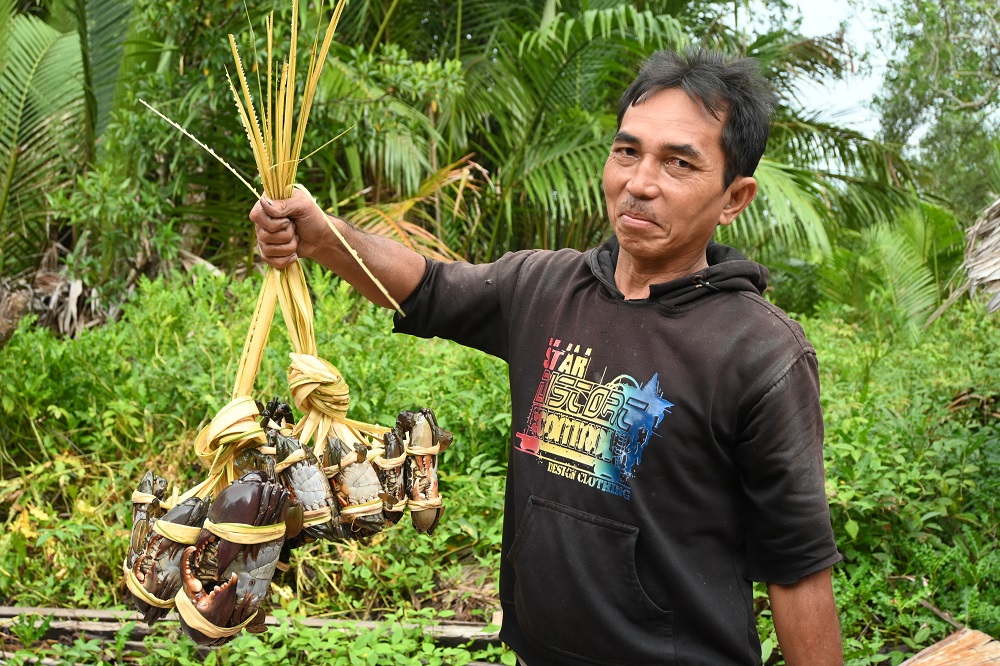 Mud crab fishermen in Parit 18, Sapat Subdistrict showing their catch (Wahyudin Opu/Blue Forests)
Mud crab fishermen in Parit 18, Sapat Subdistrict showing their catch (Wahyudin Opu/Blue Forests)
Even though it is located far from the center of the crowd, Andi Masrapi’s house (45 years) rarely looks empty. Apart from being a place to live, the wooden stilt house in Parit 18, Sapat Village, is also used as a place to run a business by the owner. The man who is usually called Rapi runs a grocery shop and fishery product collector business at the house. The two businesses became his main livelihood after his coconut plantation at that location began to deteriorate.
Until 2015 the coconut plantation in Parit 18, Sapat Village, Indragiri Hilir Regency, Riau Province, was still productive. According to Rapi’s confession, every time he harvests, his coconut plantation is able to produce tens of thousands to hundreds of thousands of coconuts. This figure has contributed to the statistics of Indragiri Hilir Regency as the largest coconut producing district in Indonesia.
However, the heyday of the coconut plantation in Parit 18, Sapat Village, is now just a memory. Rising sea levels have damaged hundreds of hectares of coconut plantations in the area. The artificial embankment is no longer strong enough to withstand the intrusion of salt water that penetrates into land that was once land. Dead coconut trees. In less than ten years, the view of the green palm trees on the land has now changed to stands of coconut trees that have died wither.
Most of the people who used to live in Parit 18 then left the location. Some moved to the center of Sapat Kelurahan, some headed to Tembilahan, the capital of Indragiri Hilir Regency, to seek a new life.
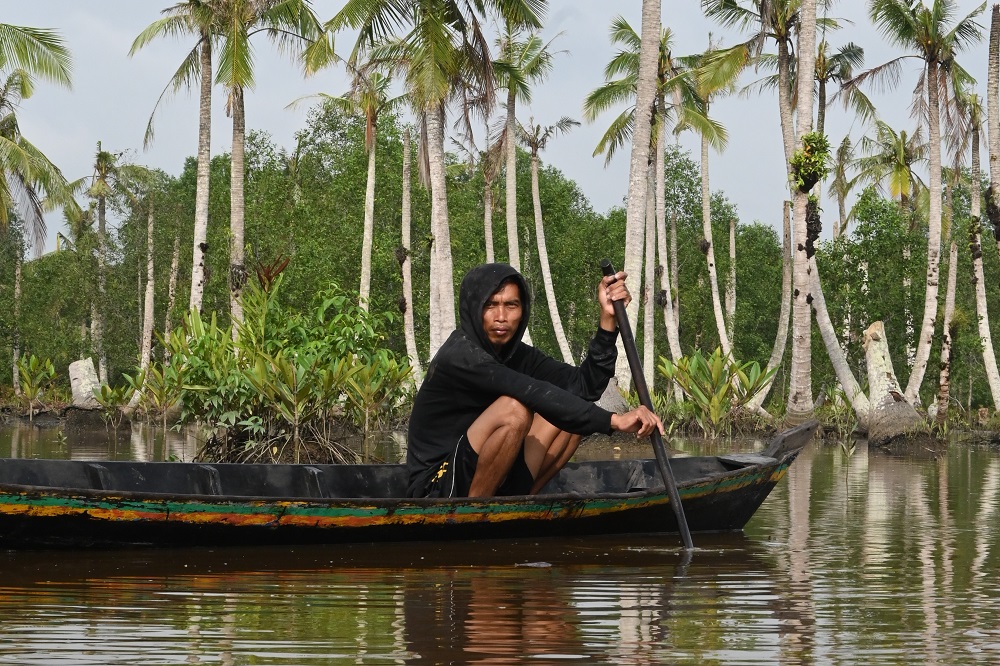 A fisherman rowing a canoe in a former coconut grove submerged in sea water in Trench 18, Sapat Village (Wahyudin Opu/Blue Forests)
A fisherman rowing a canoe in a former coconut grove submerged in sea water in Trench 18, Sapat Village (Wahyudin Opu/Blue Forests)
But Rapi and a small part of the community still survive there. He still hopes to maintain his remaining coconut groves, while seeking a new livelihood.
“We’ve just given up. In other words, fortune has been arranged by God,” explained Rapi briefly in response to the damage to his coconut plantation.
But behind their surrender, Rapi and the people who survived in Parit 18 are now carrying out new livelihoods that they might never have thought of before. Now Rapi is a fishery product collector in the form of mangrove crabs (Scyla spp.), lokan (Gelo’s eros) as well as various types of fish and shrimp. While the rest of the community turned to become small-scale fishermen with the catch being accommodated by Rapi.
This could happen due to changes in the landscape of the submerged coconut plantations in Trench 18. Gradually the coconut plantations in Parit 18, Sapat Village, which had been affected by the tides, began to grow mangrove communities. The growth of mangroves also presents a variety of fishery biota that have economic value. The people who previously worked as coconut farmers turned to catch fishermen. Broken nature and the people in it find a new balance.
The change in the landscape of a coconut plantation to a mangrove forest in Parit 18 also provides new knowledge for Rapi and the local community. That the presence of mangroves in the former coconut groves that sank brought its own blessings to the fishing communities there. The thickness of the mangroves that grow is proportional to the number of fishery products that can be utilized by them.
Based on this knowledge, the people of Parit 18 Kelurahan Sapat welcomed the presence of the Blue Forests Program implemented by the Blue Coast Partners Consortium. In this consortium, the Blue Forest Foundation is collaborating with the Mitra Insani Foundation and the Pesisir Lestari Foundation, with funding support from the UK AID-ICF (International Climate Fund). The program being implemented aims to protect and restore mangrove forests and their ecosystem services, as well as prevent the release of carbon emissions and support secure livelihoods for coastal communities. One of his work locations is in mangrove and coastal ecosystems in Indragiri Hilir Regency, Riau Province.
Trench 18 in Sapat Village is now a learning location for livelihood development that relies on preserving natural resources, namely the mangrove ecosystem. Together with the local community, the Blue Forests Foundation carries out mangrove rehabilitation activities using aEcological Mangrove Rehabilitation (EMR) in former coconut plantations which were intruded by sea water. Meanwhile, the activities to collect data on the potential of mangrove crabs and the protection of their fishing grounds were carried out by the Mitra Insani Foundation with technical support from the Pesisir Lestari Foundation.
“The products from this coconut plantation are no longer there. we better use it for mangroves. So that the crabs can also thrive in that place,” Rapi answered when we asked him why he gave up his land to be rehabilitated into a mangrove forest.
 The process of marking locations and building an understanding with land owners (Wahyudin Opu/Blue Forests)
The process of marking locations and building an understanding with land owners (Wahyudin Opu/Blue Forests)
The stages of mangrove rehabilitation covering an area of 6.8 hectares in a former coconut plantation in Parit 18, Sapat Subdistrict, have been going on since June 2022. It started with social preparations in the form of building an understanding with the land owners. The process of building an understanding for the implementation of mangrove rehabilitation in the former coconut plantation in Parit 18 went relatively smoothly. This can happen because an understanding of the importance of mangrove ecosystems to support the livelihoods of fishing communities has been built in the landowners and local communities.
Rapi as the owner of the land to be rehabilitated voluntarily surrendered his land, without material compensation. Rapi also co-ordinated local fishermen to be involved in the implementation of rehabilitation. The social stage in the form of securing this kind of tenure aspect has always been the concern of the Blue Forest Foundation in every implementation of mangrove rehabilitation.
 Baseline survey to assess the condition of the site to be rehabilitated (Wahyudin Opu/Blue Forests)
Baseline survey to assess the condition of the site to be rehabilitated (Wahyudin Opu/Blue Forests)
Before carrying out rehabilitation, carried out baseline survey on the land to be rehabilitated.This activity aims to collect information on ecological, hydrological and disturbance conditions at the site to be rehabilitated, as a reference for preparing a rehabilitation design as well as to obtain initial condition data (T0) before rehabilitation is carried out.
Based on the results baseline survey, a participatory rehabilitation design was prepared with the parties and all elements around the site, including the sub-district government, mangrove rehabilitation practitioners, namely the Village Forest Management Institution (LPHD), as well as landowners and the local community. In this discussion session, several rehabilitation methods were agreed, namely, planting seeds, sowing seeds, transferring seedlings (wilding), as well as seeding with poly bag media. While the agreed type of mangrove is pedada (Sonneratia caseolaris) and flames (Avicenia alba). These two types of mangroves were selected for their suitability with the reference forest around the location as a supplier of seeds and seedlings.
The implementation of mangrove rehabilitation in the former coconut plantation in Parit 18, Sapat Village, was carried out in two stages. The first phase will take place on 15-18 September 2022, and the second phase will be on 29 November-1 December 2022. This activity involves 40 people who are local people who are coordinated by the land owner. Rehabilitation participants shared roles in various stages of implementation, including repair/restoration of hydrology at the site, preparation of seeds and seedlings, land clearing of disturbance factors in the form of piyai plants (Acrostichum sp.), dispersal and planting seeds/seeds, as well as sowing seeds. Everything is implemented based on the agreed rehabilitation design.
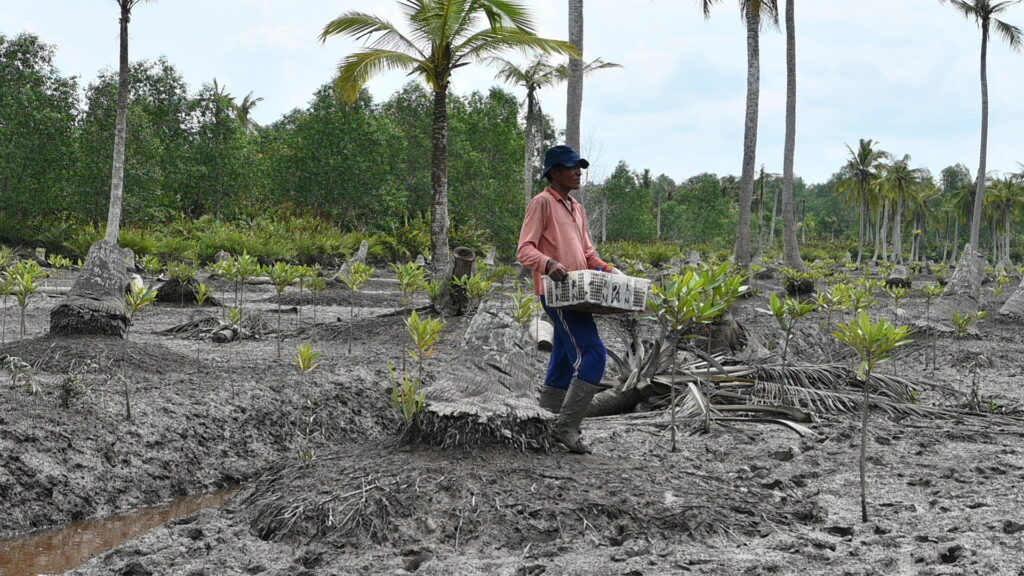 The process of sowing mangrove seeds in former coconut plantations which are intruded by sea water (Ehdra Beta Masran/Blue Forests)
The process of sowing mangrove seeds in former coconut plantations which are intruded by sea water (Ehdra Beta Masran/Blue Forests)
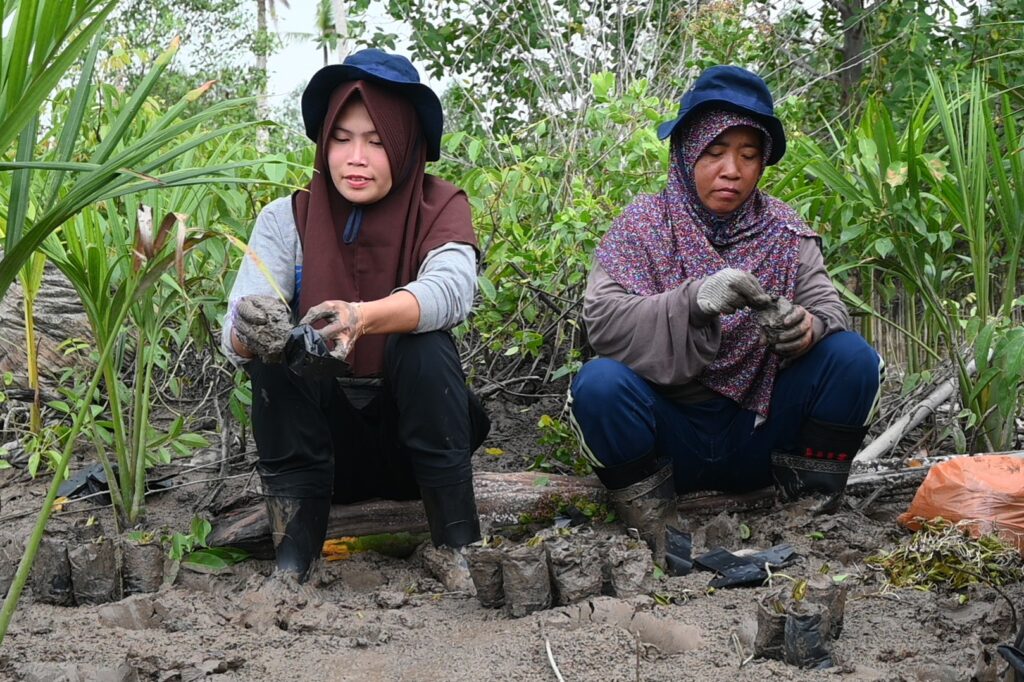 Two female fishermen are involved in planting mangrove seeds around the rehabilitation site (Moulidya PN/Blue Forests)
Two female fishermen are involved in planting mangrove seeds around the rehabilitation site (Moulidya PN/Blue Forests)
Three months after the implementation of rehabilitation, scientific and participatory monitoring was carried out. Monitoring scientific carried out using the same method Survey baseline, by comparing the results before and after rehabilitation. Meanwhile, participatory monitoring is carried out using a simpler method by involving the community and land owners who are involved in the rehabilitation process.
Monitoring results show positive progress on the rehabilitated land. Shown by increasing the value of density on the type Avicennia alba and Sonneratia caseolaris. This indicates that the seeds and seedlings implemented during the rehabilitation managed to grow well. This kind of monitoring activity will be carried out periodically in the next year, with the assumption that this period is a crucial time in the mangrove growth stage.
Aside from being an effort to preserve the mangrove ecosystem, the rehabilitation that was carried out in Trench 18, Sapat Village, was also used as a learning tool for the local community involved. Samsuri (28 years), a fisherman, admits that he understands more about the stages in implementing mangrove rehabilitation. “It is important to clear the land first before planting. I also understand which seeds are superior and suitable for planting in our area,” said the man who lives around Trench 18.
The procedure for selecting and treating mangrove seedlings is also felt to be a new learning by the participants. “The experience of following this rehabilitation activity, we have come to know how to breed api-api species. Never done before. But now we have done it and we can see the results that we have planted in the location,” explained Rapi.
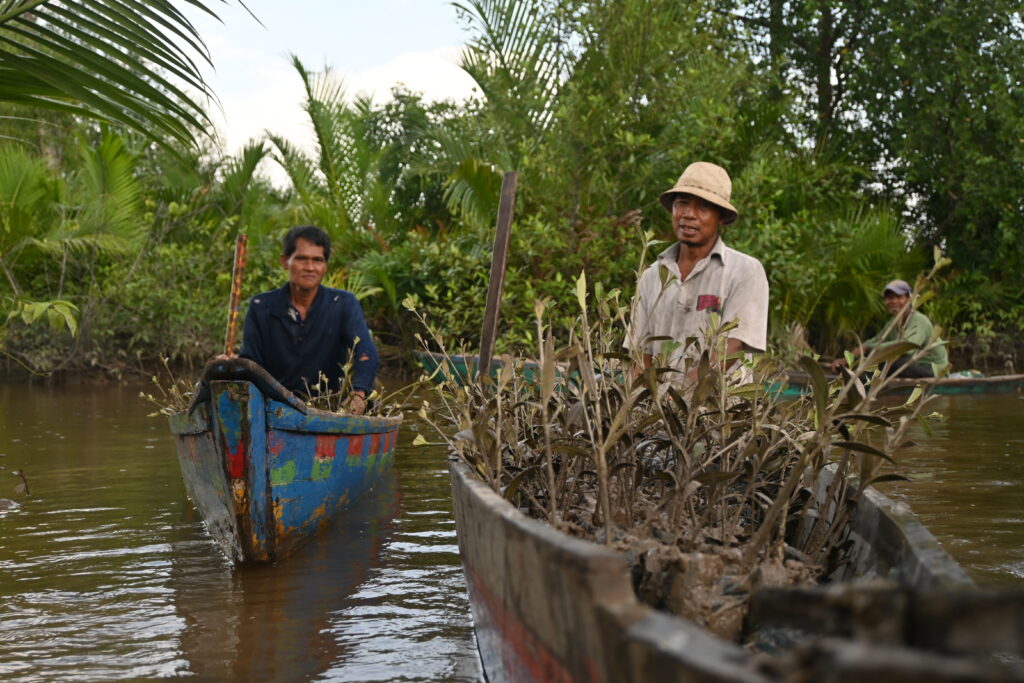 The process of transferring mangrove seedlings that have been sown before to the planting location (Wahyudin Opu/Blue Forests)
The process of transferring mangrove seedlings that have been sown before to the planting location (Wahyudin Opu/Blue Forests)
Meanwhile, participants also expressed hopes for the successful rehabilitation of mangroves to support the livelihoods of fishing communities. Mala (27 years), a fisherwoman who is involved, hopes that the mangroves she has planted will grow well. “So that the crabs also grow more. So it’s good that later we fishermen will try it.”
Efforts to rehabilitate mangroves in Trench 18 have not been fully successful. The process of monitoring and maintaining the locations that have been intervened is still needed to ensure their growth. However, the hope that is accompanied by knowledge of the importance of mangroves for livelihoods has begun to grow among the people there. That the preservation of mangrove ecosystems will strengthen the resilience of coastal communities. Resilience that is not easily broken when facing climate change which is increasingly evident.

